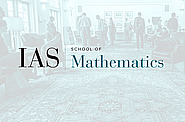2022-2023 Seminars
Feb
20
2023
Computer Science/Discrete Mathematics Seminar I
Induced Subgraphs and Tree Decompositions
11:15am|Simonyi 101 and Remote Access
Feb
14
2023
Computer Science/Discrete Mathematics Seminar II
Rainbow Matchings in Hypergraphs
10:30am|Simonyi Hall 101 and Remote Access
Feb
13
2023
Computer Science/Discrete Mathematics Seminar I
Efficient Verification of Computation on Untrusted Platforms
Yael Kalai
11:15am|Simonyi 101 and Remote Access
Feb
07
2023
Computer Science/Discrete Mathematics Seminar II
Overview and Recent Results in Combinatorial Auctions
Matt Weinberg
10:30am|Simonyi Hall 101 and Remote Access
Feb
06
2023
Computer Science/Discrete Mathematics Seminar I
Smooth Coverings of Space
11:15am|Simonyi 101 and Remote Access
Jan
31
2023
Computer Science/Discrete Mathematics Seminar II
A Subpolynomial Approximation Algorithm for Graph Crossing Number in Low-Degree Graphs
Zihan Tan
10:30am|Simonyi Hall 101 and Remote Access
Jan
30
2023
Computer Science/Discrete Mathematics Seminar I
On Matrix Multiplication and Polynomial Identity Testing
Robert Andrews
11:15am|Simonyi 101 and Remote Access
Jan
24
2023
Computer Science/Discrete Mathematics Seminar II
Locally Decodable Codes
10:30am|Simonyi Hall 101 and Remote Access
Jan
23
2023
Computer Science/Discrete Mathematics Seminar I
Non-measurability of the inverse theorem for the Gowers norms
11:15am|Simonyi 101 and Remote Access
Dec
13
2022
Computer Science/Discrete Mathematics Seminar II
A Characterization of Multiclass Learnability
Nataly Brukhim
10:30am|Simonyi Hall 101 and Remote Access
